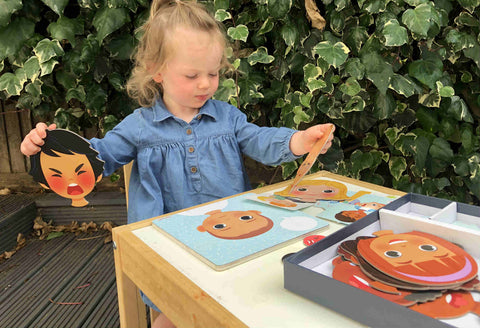Learning to focus, learning to feed, learning our numbers and our ABCs. Life is pretty much one long learning journey! And learning to manage our feelings is a big part of that voyage. But, unlike learning to walk or talk, learning to handle our emotions doesn't come instinctively: small people need lots of guidance, modelling and practice.

The good news is that the help we give makes a huge difference. The more we talk with kids about their emotions, the more we enable them to cope with 'big feelings' and resolve challenges and frustrations when they arise. Which sets them up for success in life in so many ways. Let's find out how:
'When little people experience big emotions, it is our job to bring the calm, not join the chaos.'
L.R. Knost
Little Hearts, Gentle Parenting
It’s been shown that kids that can problem-solve emotional issues from an early age are better able to focus, learn, form friendships and navigate social situations. (So get practising these strategies as soon as you can!) When your toddler or child feels frustrated or overwhelmed, guide them through this 4-step process:
- Calm down
- Talk about their feelings & the situation
- Problem-solve
- Praise them
When a blow-up happens it can be tempting to skip ahead and miss out the first 'calm down' stage. But don't. Only when a child is physically calm can they talk about what's going on inside them. And only once they've shared their feelings can they start to think of solutions. So take it from the beginning.
1. CALM DOWN
As soon as you notice your child's upset, try saying something like, “It looks like this is a good time to calm down. Let’s take a deep breath together.” Or maybe, “It looks like you might be feeling sad about something. Shall we sit somewhere nice and quiet and talk about it?” Find a quiet spot, get them to put their hands on their tummy and take several deep breaths, 'feeling' their breath go in and out.
2. TALK IT THROUGH
After they’ve physically calmed down, praise them. Point out that “You took a breath and calmed down. That’s great! Now you can tell me how you’re feeling and what the problem is. Then we can figure out how to solve it.” Naming feelings takes practice, though. And when they're very young, kids don’t have the words to describe their emotions, and they also struggle to ‘read’ other people's.
In fact, all humans vary widely in their intuitive abilities. So some kids will find naming emotions and understanding other people easier, some will find it harder. (Neurodiverse kids in particular - like those on the autistic spectrum - can find emotion-naming and reading others especially challenging. They might have to work hard, over a long period of time, to find strategies to develop these skills.)
But, thankfully, books and games can really help.
Thankfully, books and games can really help with naming feelings and finding solutions. Some of our favourites are:

Janod's Emotions Magnetic Game
A really useful game, devised by psychotherapists, that helps you talk about feelings through play and using real life situations. There are 10 emotional states for them to recognise - joy, fear, sadness, anger, shyness, love, disgust, laughter, jealousy and surprise. It has two levels of play, for both younger and older children, and a mirror in the box so they can see the faces they're pulling to match the feelings on the different faces.

bookspeed's Feeling Books
These great little reads help kids navigate complicated emotions like sadness and loneliness, but also positive ones like bravery too, and feature endearing characters like clouds and rainbows that they'll easily relate to.
Abrams & Chronicle Books' Feelings
Kids are introduced to Little Crocodile and his friends, who have a great time expressing how they feel. With tabs to pull, the pictures in the book change to reflect what's happening in the story.
You don't need to wait for a crisis....bring the topic up as it feels natural throughout the day.
Of course, talking about emotions shouldn't just happen when they're upset. Don't wait for a crisis - use these books or just bring the topic up as it feels natural throughout the day. When you’re reading a story book or watching a TV show, you can discuss the characters’ emotions. Explore their facial expressions and think about their body language too. (Sometimes it’s easier to do this with still images, especially for younger children, which is why illustrations in story books can be brilliant.)
Remember, feelings are positive too! It’s just as important to talk about happiness as it is to talk about sadness or worry.

Also, help your child to make the connection that all feelings are acceptable, but not all behaviour is acceptable. For example: “It’s ok you felt frustrated when you had to wait your turn on the slide. It is not ok to push in.” Getting in the habit of communicating their feelings with their playmates is also very important and this leads onto the next part of the process: problem solving.
3. PROBLEM SOLVING
Once they’ve explained how they feel, it's time to come up with a solution. This might involve helping them to see things more broadly - ‘Everyone wants to go on the slide, so when you wait your turn, you’re being considerate to your friends’ - or diversionary tactics - ‘Why not jump on the trampoline while you wait for the slide?’ - or by asking for help - ‘If you told Josh it’s your turn and he still didn’t let you have your go, you're right to ask me or another grown-up for help.’
4. Praise them
Make sure you give kids lots of praise when you see them actively problem-solving. For example, “Ella, I saw how you calmed down and told Josh how you were feeling. Then you talked about taking turns so you could both enjoy the slide. You were both great problem solvers!” Be very specific when praising their efforts. This helps them to really understand the theory and the process.

SOME USEFUL APPS
The Mindfulness Monster on CBeebies Go Explore - Free / Age 0-5
Go Explore is a fun kids app packed with free CBeebies games and videos based on the early years curriculum. The Mindful activities from Love Monster include breathing techniques to help support your child’s wellbeing.
Moshi Kids - Subscription-based, 7-day free trial available / Ages 0-10
A social-emotional learning and mindfulness app for kids, with exercises and stories that help them relax, reduce anxiety, and manage negative thoughts. There are various breathing and meditation exercises that, because they're child-led, really help small people feel involved in getting their emotions in control and being aware of others' feelings too. It's also a great resource for pre-bedtime as it's screen-based but calming, so it's a brilliant alternative to TV and tablets.
Mindful Powers - Free / Ages 4+
Says that it 'takes a holistic approach to helping young minds learn and practice mindfulness so they can respond more effectively to stressful situations through the power of play. Built on a skills-based approach that helps children in early and middle childhood build a healthier relationship with life, stress, and anxiety'.
Breathe, Think, Do with Sesame - Free / Ages 2+
From the makers of Sesame Street, an app that helps preschoolers learn how to deal with frustrating situations, using the 'Breathe, Think, Do' method. There are a limited number of scenarios to work through, but they do drum home the three stage process very effectively, during which kids learn to help a blue monster take deep breath by tapping his belly. Then they pop bubbles while the monster thinks of possible solutions to problems and subsequently help him choose which plan to implement.
FURTHER READING:
Using Emotional Language: How to Talk to Your Kids About Feelings
Talking With Preschoolers About Emotions
We hope that in learning how to talk to kids about their feeling, you end up feeling calmer and happier as a parent or carer too. And remember, if you need any more guidance, our Live Chat Team is always here to help, from 9am to 5pm, Monday to Friday. Just hit that purple button, bottom right.
Picture credits:
Upset Lego man & sad egg: Hello I'm Nik at Unsplash
Boy looking out window: Idzard Schiphof at Unsplash
Happy girl: Jose Ibarra at Unsplash












